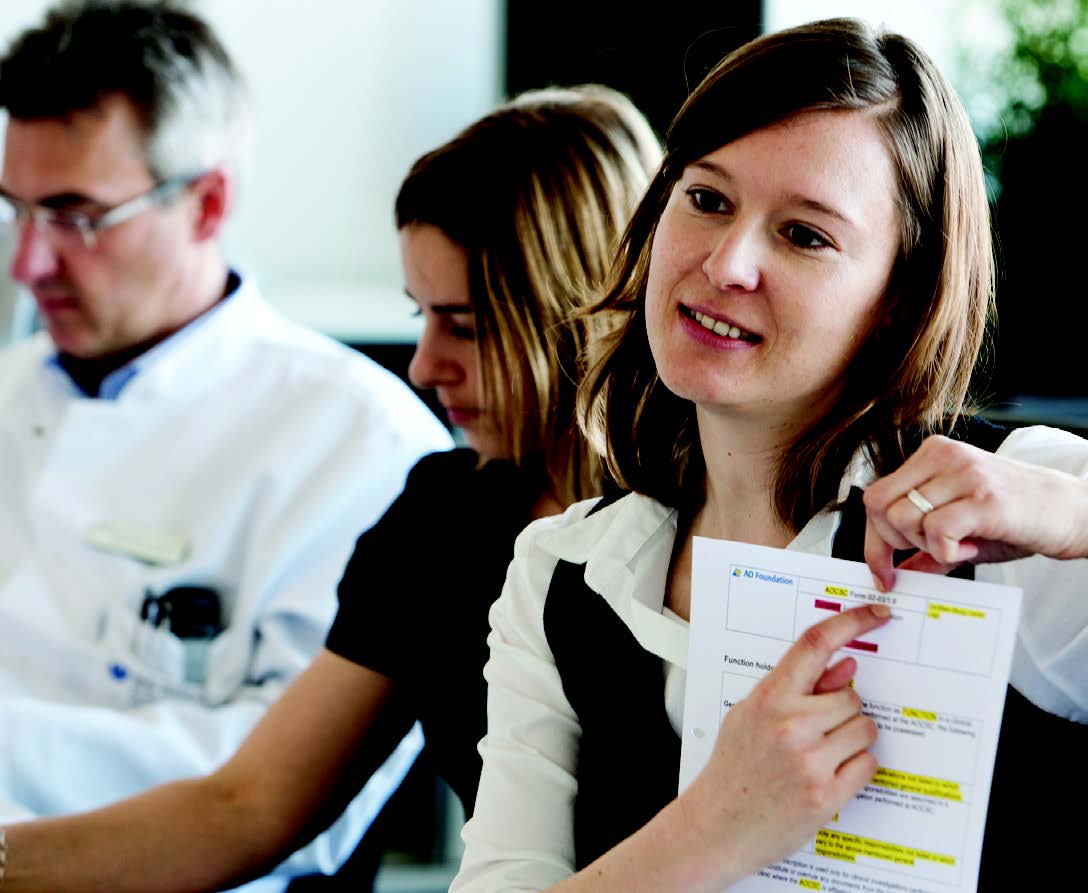This article does not specifically deal with the situation for clinical research in Thailand. Instead, just as we conduct multicenter studies to ensure that the results are generalizable, the following points are some practical tips derived from the AO Foundation’s long experience in the conduct of multicenter clinical trials around the world and as such, have general applicability. If you require more targeted information, a simple Internet search will reveal many useful addresses with country-specific information (such as the Thai FDA: www.fda.moph.go.th).
While many researchers are interested in publishing studies, the publication that results from a study is just the tip of the iceberg. It is the visible end-product of many phases which have contributed to a study’s success. The planning and study design stage is absolutely critical which is why it is the only section highlighted and presented as a step-by-step process here.
1.Do preliminary research
Find out more about the topic that interests you (e.g. search on PubMed, the Cochrane Library, hold discussions with your colleagues, consult professional forums etc.). Ensure your idea has not already been tried.
2.Consider the purpose of your study
What is the rationale for conducting your study? Why was the new implant developed and what’s its added value? What makes the new technique more beneficial for your patient compared to the standard approach? Can you find a way to compare A to show it is better than B? If you think of your idea as being simply “interesting to look at” then you should seriously reconsider trying to conduct a trial on it. Another possible question to ponder is what possible results from the trial are likely to change clinical practice / improve patients’ lives?
3.Plan your clinical question carefully
Your clinical question will determine how good your study is, so define it very precisely. It is the bedrock upon which your study’s success will be built. The PICOT acronym (Patient, Intervention, Control, Outcomes, and Timing) is a very helpful scaffold upon which to start building your research. For example, if you have a diagnostic question you might consider the following PICOT factors:
Patient - Which patient group? Consider patient characteristics that may affect outcomes.
Intervention - Define the diagnostic procedure of interest (e.g. a new technology).
Control - Is there a gold standard? If necessary, you have to define the ‘control’ group to which the intervention group will be compared.
Outcomes - Be specific and aim for the most important outcomes (e.g. nonunion, major complications, death, etc.).
Timing - How long will the study last? How many follow-up visits and when?
4. Find an acceptable study design
Decide on this very carefully once all the necessary information is to hand.Let your clinical question and resources guide your choice of study design.
5.Sample size and feasibility
A sample size of 500 patients in an indication where you see 20 patients yearly is not going to work. Be aware of Lasagna’s Law which states that the number of patients available to join a trial drops by approximately 90% the day a trial begins, only to reappear as soon as the study is over. Remember that some fracture types are rare. Be prepared for such studies to only recruit small amounts of patients and for their recruitment to be painfully slow.
Two to five years follow-up is a very difficult task. Once healed, injured patients often do not return to their doctor so in most cases you will have to chase them up.
6.Implement a study design freeze at an early stage
Don’t have the design questioned at every meeting. Good Clinical Practice dictates that you cannot change a study design once the first patient has been recruited.
7.Clearly define everything in the study protocol
This is an essential document which allows you to ensure uniformity for all the investigators and sites involved in the study.
8.Don’t make your inclusion criteria too restrictive
Obviously you need to exclude certain types of patients but be careful that you do not shut out those who may still be acceptable for the study’s purposes. Broad exclusion categories such as ‘active systemic infection’ should be more exactly defined to help widen the net of eligible study participants.
Have clear communication with stakeholders throughout the study process
At AO Clinical Investigation and Documentation (AOCID), in addition to the regular updates through meet- ings and personal contact, we send out a newsletter for each study approximately 3 times a year to ensure that all the stakeholders are aware of how things are progressing. Provide information on the number of patients included and the follow-up rates for each site.
Define roles, and trust in the other’s expertise
The Principal Clinical Investigator (PCI) is the expert in the operating room but the Clinical (or Contract) Research Organization (CRO) is the expert in the planning and conduct of the study. A mutual respect for one another’s competencies helps the process along.
Regulatory problems with the medical device approval process
The approval process can vary from country to country and lead to bottlenecks in the study. Do not assume your planned national timeline will hold true for international studies.
Do not forget to get informed consent
There are intrinsic elements to trauma studies which make obtaining informed consent difficult. You may be faced with unconscious patients, or find it difficult to explain the study as the patients are in pain. Similarly, it may be hard to obtain consent as patients could be whisked into the operating room within a short time after admission. Prepare for this and make allowances in the study protocol, e.g., by allowing proxy consent if appropriate.
Comorbidities
Consider your patient cohort carefully as comorbidities can play a negative role in follow-up rates. For example, mortality rates of approximately 30% in elderly patients with hip fractures will naturally lead to low follow-up rates.
Rehabilitation protocol
Be aware of the effect that this can have on outcomes. Ensure that the same standardized procedures are in place in all participating centers.

A study project manager liaising with a study coordinator in the clinic

Initiation visits are very important to a study’s success
Respect cultural differences if you perform a study in different countries
Use only patient-assessed scores that have been cross- culturally adapted and validated. Do not translate scores yourself for clinical use.
Avoid selection bias
Consider the population you would like to make inferences about and whether your sample size is truly representative of it. Not all conclusions may be transferable to other population groups. If there is a possible selection bias it is essential that this is also reported (e.g. conducting a study in the military among young healthy males).
Do not be shy about reporting complications
Knowledge of complications is very important to the improvement of patient care. So try to shake off the feeling that comprehensive and complete reporting of com- plications will handicap your chances of publication, reflect badly on your surgical skills etc. In the end, it will assist many more patients and help to avoid future adverse events.
Find out and follow the legal framework in place
Remember that there is no clinical study without ethics committee approval and the patient’s informed consent.
Ensure your clinical study has been entered into a registry
It’s a prerequisite for publication in many journals these days. The best-known is probably www.clinicaltri- als.gov but there are other registries such as www.anzctr. org.au which are also acceptable.
Get agreement from all parties before proceeding with ethics committee submission
It should be borne in mind that there is a cost to submitting and resubmitting to ethics committees. For example, the cost of submitting to a German ethics committee is generally around €1,500. You may have to apply to several such committees and their processes can vary – even within the same country. This is an element which is often underestimated in planning international multicenter trials.
Make sure your study center personnel are adequately trained
The initiation of a study is crucial. Ensure that all material is available and that enough time is given to train all the relevant personnel. Get them to “buy into” the study from the very start so that they are actively screening patients for recruitment in their daily clinical practice.
Early monitoring may save you future headaches
A first monitoring visit / check after only a few patients have been recruited can help to identify and correct systematic mistakes at an early stage, thereby saving a lot of time later on.
Try to anticipate issues and to head them off
For example, be aware that less experienced staff members at your center will probably require closer support and more training and supervision than others.
Keep your database constantly clean
This means ensuring that there is ongoing monitoring, ongoing data checks, and so on.
Data management
Have adequate procedures in place to ensure data quality. Do not wait until tomorrow to reply to a request if you can do so today.
Don’t be afraid to delegate
You’re most likely working full-time and are in the operating room most of the time. If your center can afford it, consider hiring a study nurse to manage your study documentation and data for you. AOCID has had very good experience with this arrangement.
Define clear timelines
Remember that with so many actors involved the review and approval process can take a long time – which can be frustrating when you are so near your goal.
Finally, share your work with the world!
Do not forget to celebrate your achievements. Submit your manuscript to a journal, be prepared that rejection and resubmission happen to almost everyone, go to conferences and share your new knowledge with the scientific community.
For more information on conducting clinical studies and information about AOCID’s services, please visit www.aofoundation.org/cid or write to us: aocid@aofoun- dation.org.